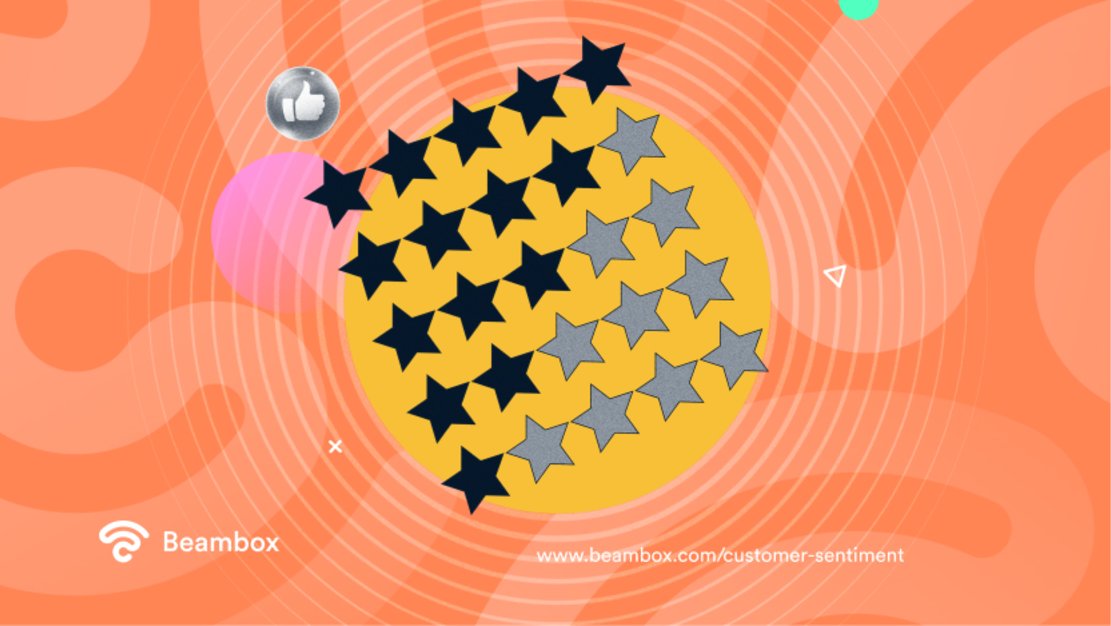Customer sentiment is number one on a list of things that matter in business. Simply put, customer sentiment is the backbone of healthy profit margins. The term encompasses everything from customer satisfaction to customer loyalty and all the other elements of customer experience. The sentiment is customers’ overall feeling when interacting with or reflecting on your business. And this sentiment can be measured and analyzed to provide actionable insights.
Even after just that brief introduction to sentiment’s importance, it’s easy to see how essential it is for your business. A negative experience for customers could dramatically damage your profits and even endanger business survival. To achieve true success, you must effectively harness and consistently monitor this.
In this guide, we’ll take you on a complete journey through all the elements of sentiment analysis. We’ll look closer at sentiment analysis and actionable steps, such as finding sentiment software. These essential pieces of information will combine to create a comprehensive tool kit. And with this tool kit, you can start utilizing sentiment analysis for your business. Who knows, perhaps you’ll jumpstart your sentiment utilization today.
What Is Customer Sentiment Analysis?

Okay, so you’ve had a basic introduction to customer sentiment analysis. In essence, it entails a measurement of how customers feel about your business. It can also cover more qualitative data on their experiences while interacting with you. The data that you analyze is massively personal to you and your business. You could collect qualitative data on customers’ feelings and individual experiences in detail. Or you could collect quantitative data using numbers on scales to reflect customers’ sentiments.
Considering the different data types you can collect, it’s no wonder that measuring sentiment can be undertaken in many ways. A popular method is by requesting customer feedback. This could be through surveys on order confirmation emails, restaurant QR codes, or exchanges for restaurant rewards like coffee. Requesting customer feedback is brilliant for improving customer relations, as it makes people feel valued and listened to. It also provides a space for customers to vent clearly outside of the public domain. Sentiment analysis is helpful on a few fronts.
In sentiment analysis, you group this data into a single document and extrapolate any emerging trends and patterns. This is the most vital part and where the actual analysis kicks in. With all the customer feedback in a single place, you can easily see any common topics. For instance, you may find out that 85% of customers found the wait time tedious. Or similarly, 70% of customers love the new dish you added to the menu last week. Often, especially when using software analysis tools, you’ll calculate a sentiment score for a general idea of customer satisfaction.
Think of sentiment analysis as a quick check-in with your customer base. You ensure you’re on the same page by using an analysis tool.
How To Interpret Your Customer Sentiment Score

You receive a customer sentiment score when you conduct sentiment analysis using software. These scores range from 0 to 100. The easiest way to interpret scores at first glance is to know that 100 is brilliant and 0 is awful. To get a positive sentiment score, you ideally want to see your score between 90 and 100.
While you can measure sentiment scores immediately with these scores, it helps if you can interpret results more deeply. And the best way to do this is to understand how the scoring system works. With quantitative data (purely numerical results like ranking systems), sentiment scores are easy to calculate. The software just tallies up numbers. But with qualitative data, things get a little trickier.
With qualitative data, the software measures the amounts of positive and negative words. For example, giving one point for the word ‘excellent’ and deducting one point for the word ‘slow.’ So when analyzing your score, you’d know that if you lost 10 points, there were 10% negative words. To improve, you can screen for this 10% of words and brainstorm how to eradicate that aspect of negative experience.
Similarly, using your sentiment score to interpret what’s going great in your business is essential. Positive things deserve praise - whether you celebrate by yourself or reward your staff. Use 90% of positive words in this scenario to celebrate the aspects you are doing well. And pass this information on to staff so the whole team can understand what works and what doesn’t.
Your customer sentiment score is a valuable tool. Once you figure out how to measure it, improving and better understanding your business is easy.
What Are the Best Customer Sentiment Analysis Benefits?

Customer sentiment analysis is essential for understanding your customers and running a successful business. But you already know that. Sentiment analysis is one of the most valuable tools you can invest in for your business. What are the lesser-known, more specific benefits of sentiment analysis? You can take advantage of these top benefits by investing in sentiment analysis.
Improve Customer Service Through Customer Sentiment Analysis
Improving customer service is a massive benefit of sentiment analysis. Having fantastic customer service is the best way to attract and retain customers. Excellent service means loyal customers, and loyal customers mean extraordinary profits. By using sentiment analysis, you can highlight which areas need improving and which areas you perform well in. For instance, customers might think your waiting times are super efficient. However, they might mostly find your chatbot ineffective. With these insights, you can tune your customer service experience - creating a brilliant relationship with customers.
Track Trends Through Analysis
Tracking trends is one of the sneakiest ways to use customer sentiment analysis. You can track emerging trends by questioning customers about more general things like recent purchases and product preferences. For example, your customer might be looking for cafes with ethical, fair-trade foods. In this case, you can be more transparent about where each dish’s ingredients have come from.
Tracking trends is fantastic for making your customers feel heard. It’s also incredible for getting ahead of the curve to capitalize on meeting the trend before others do. And sentiment analysis is brilliant for bringing this news straight from the customer.
Manage Your Online Reputation
Customers who have somewhere to channel their frustrations are less likely to plaster negativity online. By collecting customer feedback for customer sentiment analysis, you are giving people a space to feel heard. And you are directing negativity to a private place rather than attempting to resolve it publicly. It’s important to note that removing bad reviews from many places online is impossible. So if you aren’t proactive, it’s easy to get your business reputation tarnished by unhappy customers. Utilize sentiment analysis and get the most out of the situation.
Analyze Competitors
Another huge bonus of customer sentiment analysis is that it allows you to analyze competitors. You don’t just have to analyze your direct customer base; you can analyze online data. Analyzing online reviews from many competitor products is the best way to see what makes customers choose each one. Using this technique is vital for ambitiously building a successful business. You can better understand the market you are operating in and how to beat competitors.
Use Customer Sentiment Analysis To Direct Your Ad Content
If you rely on ads or sponsorships in your business, sentiment analysis is a brilliant step to take. Sentiment analysis helps you discover your customers’ preferences and target them with ads of interest. If most of your customer base are vegetarians, advertising your local butchers is not intelligent. While if you attract lots of cyclists, advertising the new bike repair shop down the road would be a hit.
These five benefits of sentiment analysis are great reasons to start ASAP. You can grow all aspects of your business - from directly increasing profits to widening marketing potential. You have two main choices to move forward: software or manually conducting analysis. Software analysis is the easiest, and you can get some budget-friendly options. Check out our next section for more direction on finding customer sentiment software.
The Top Customer Sentiment Software To Get Started

Ready to start looking for customer sentiment software? Brilliant. This is the most crucial step that you’ll take when building up your sentiment analysis strategy. You should choose software that provides actionable insights, sentiment scores, and consumer behavior insights. The more precise the information and the more information it provides, the better. Of course, you’ll also want to consider your budget too - do you want something free? Or perhaps something that costs more but provides extra services? Let’s take a look.
Hubspot is a well-known software in the world of internet marketing. Using surveys builds a file on customers’ feelings towards the business. The customer feedback tool is fantastic for killing two birds with one stone - making data collection easier. And once the data is there, you get a user-friendly dashboard to analyze everything.
Hubspot’s pricing starts at around $45 a month. So it best suits those wanting to make a substantial upfront commitment.
Brand24 is primarily a media monitoring tool. It monitors your socials and automates data collection. It extracts information about your business from the internet - trawling forums and blogs to gauge customer sentiment.
While Brand24 costs $49 per month for a standard plan as of 2023, it does offer a 14-day trial period. If you want to trial a sentiment analysis software before choosing whether to commit, Brand24 is fabulous.
Those on a budget - rejoice! Social Mention is a free tool that analyzes social media mentions through keyword research. While much more fundamental than paid options (forget a complex dashboard), you get valuable insights. For instance, you’ll learn about your business’s popularity on social media and how likely it is to stay popular.
Final Thoughts: How To Utilize Customer Sentiment in Business
You can best use customer sentiment by downloading software and collecting data today. Using sentiment analysis immediately and continuing to use it regularly is the most important way forward. And by choosing brilliant software, you can make sentiment analysis super straightforward - encouraging you to use it frequently.
You will need to set up customer data collection, like QR codes on menus requesting customer feedback or even QR codes on receipts or confirmation emails. Get creative with collecting customer data, as this ensures you get a varied sample pool of respondents. Then you can sync this data to your software and let your numbers work for you. You’ll get insights on marketing, competitor analysis, and more through the analysis.
Sentiment analysis is one of the best ways to improve your business from a holistic approach. Forget improving just one aspect; sentiment analysis is a cure-all. You can address all sorts of issues - whether customer service-related or poor performance against competitors. And by taking feedback from your customers directly, you get fantastic information that is honest (sometimes brutal in some cases). Getting the information and constructive criticism straight from the horse’s mouth is better, right?
Need a little more assistance with sentiment analysis? Contact us at Beambox for more information and advice on understanding and capitalizing on customer sentiment.
You can outsource your tasks to us, getting the ball rolling immediately today. Beambox has the best all-in-one Wi-Fi marketing platform. We leverage a dynamic approach to connect, capture, and keep more customers. Start your Beambox free trial today, and let us help you maximize your business potential.
Get Started With Free WiFi Marketing
Beambox helps businesses like yours grow with data capture, marketing automation and reputation management.
Sign up for 30 days free